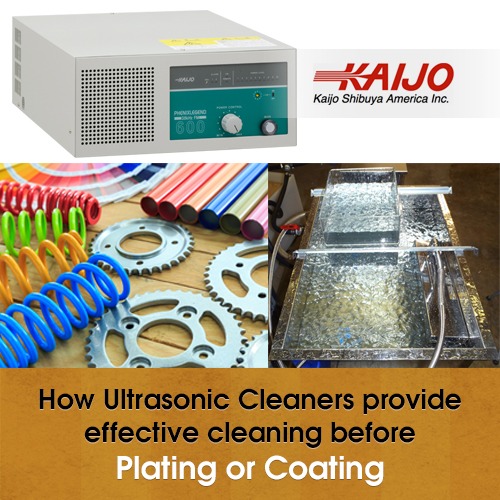How Ultrasonic Cleaners Provide Effective Cleaning Before Plating or Coating
November 8, 2018
 Ultrasonic cleaners provide quick and complete cleaning for parts to be plated or coated, saving time and ensuring superior adhesion. The ultrasonic cleaning process leaves bare surfaces free from contaminants, even in hard-to-reach places such as interior cavities and holes. The use of ultrasonic parts cleaners is completely safe and doesn’t require chemicals to soften or dissolve dirt. Benefits include faster processing, higher throughput and better quality output.
Ultrasonic cleaners provide quick and complete cleaning for parts to be plated or coated, saving time and ensuring superior adhesion. The ultrasonic cleaning process leaves bare surfaces free from contaminants, even in hard-to-reach places such as interior cavities and holes. The use of ultrasonic parts cleaners is completely safe and doesn’t require chemicals to soften or dissolve dirt. Benefits include faster processing, higher throughput and better quality output.
Why Use Ultrasonic Cleaning with Plating or Coating?
Parts to be plated or coated, such as parts made from metal or plastic, often have surface contaminants that must be removed before the plating or coating process can take place successfully. If impurities are left on the surfaces, the covering material often will not adhere to the parts and the quality of the product and its appearance will suffer.
Typical contaminants are residues from machining, buffing compound and shop dirt. Traditional cleaning methods include soaking in chemicals, manual scrubbing and washing. These methods are time-consuming and often don’t remove all contaminants in hard-to-reach places. Ultrasonic parts cleaners remove all contaminants down to the bare surfaces everywhere on the parts to be plated or coated, even from inaccessible areas such as interior openings or crevices. Cleaning is fast and complete.
How Ultrasonic Cleaning Before Plating or Coating Works
Ultrasonic cleaning systems work by producing microscopic cavitation bubbles in the cleaning tank. An ultrasonic generator delivers the high-frequency electric signal to a transducer immersed in the cleaning solution. The transducer has a surface that vibrates at the ultrasonic frequency and creates the ultrasonic waves in the liquid.
Ultrasonic waves in a liquid have high-pressure peaks and low-pressure troughs. Cavitation bubbles are created at low pressure and they collapse in the high-pressure peaks. The continuous cavitation action results in a strong scrubbing effect on the surfaces of the parts to be cleaned. Contaminating material and particles are dislodged and carried away by the cleaning solution. The process depends on the type of contaminant and how much has to be removed but cleaning is often complete after ten to twenty minutes.
Choosing the correct frequency, power and type of transducer is important for effective cleaning before plating or coating. The frequency depends on the structure of the parts and the nature of the contamination. The manufacture of some parts results in surfaces coated with heavy, oily or greasy material while other parts only have a light coating of powder or dirt. The parts themselves may be robust and rugged or delicate and easily damaged. Choosing the right ultrasonic frequency takes these factors into account.
Low frequencies such as 26 kHz or 38 kHz generate comparatively large bubbles that deliver strong, aggressive cleaning power suitable for heavy contamination of robust parts. Lighter contamination on more delicate parts can use higher frequencies with smaller bubbles and softer cleaning action. For the more delicate parts, higher frequencies in the 160 kHz to 200 kHz range deliver gentle cleaning. No matter what kind of part and what contaminants, ultrasonic cleaners can be configured with one or more frequencies that will deliver excellent cleaning performance prior to plating or coating.
Once the frequencies are determined, the power has to be adequate to fill the cleaning tank with ultrasonic waves. With adequate power, bubbles and cleaning action will appear wherever cleaning solution is present. Transducers can be built in, such as in turnkey systems, bolt on or immersible. The independent immersible units are especially flexible and can be easily be used in existing tanks, for example, if there is an existing plating or coating line with cleaning tanks already integrated.
Kaijo’s ultrasonic parts cleaners can effectively be used with any plating or coating application. In addition Kaijo will help customers select a system that will provide optimum performance to meet their specific cleaning requirements.





